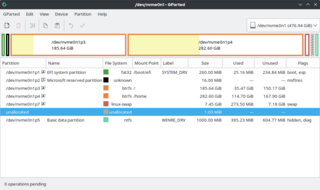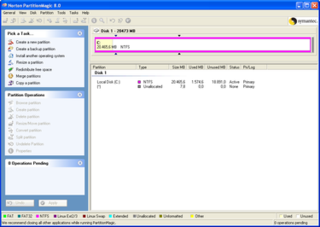
Disk partitioning or disk slicing is the creation of one or more regions on secondary storage, so that each region can be managed separately. These regions are called partitions. It is typically the first step of preparing a newly installed disk, before any file system is created. The disk stores the information about the partitions' locations and sizes in an area known as the partition table that the operating system reads before any other part of the disk. Each partition then appears to the operating system as a distinct "logical" disk that uses part of the actual disk. System administrators use a program called a partition editor to create, resize, delete, and manipulate the partitions. Partitioning allows the use of different filesystems to be installed for different kinds of files. Separating user data from system data can prevent the system partition from becoming full and rendering the system unusable. Partitioning can also make backing up easier. A disadvantage is that it can be difficult to properly size partitions, resulting in having one partition with too much free space and another nearly totally allocated.
HPFS is a file system created specifically for the OS/2 operating system to improve upon the limitations of the FAT file system. It was written by Gordon Letwin and others at Microsoft and added to OS/2 version 1.2, at that time still a joint undertaking of Microsoft and IBM, and released in 1988.

GNU GRUB is a boot loader package from the GNU Project. GRUB is the reference implementation of the Free Software Foundation's Multiboot Specification, which provides a user the choice to boot one of multiple operating systems installed on a computer or select a specific kernel configuration available on a particular operating system's partitions.
Disk formatting is the process of preparing a data storage device such as a hard disk drive, solid-state drive, floppy disk, memory card or USB flash drive for initial use. In some cases, the formatting operation may also create one or more new file systems. The first part of the formatting process that performs basic medium preparation is often referred to as "low-level formatting". Partitioning is the common term for the second part of the process, dividing the device into several sub-devices and, in some cases, writing information to the device allowing an operating system to be booted from it. The third part of the process, usually termed "high-level formatting" most often refers to the process of generating a new file system. In some operating systems all or parts of these three processes can be combined or repeated at different levels and the term "format" is understood to mean an operation in which a new disk medium is fully prepared to store files. Some formatting utilities allow distinguishing between a quick format, which does not erase all existing data and a long option that does erase all existing data.

fdisk is a command-line utility for disk partitioning. It has been part of DOS, DR FlexOS, IBM OS/2, and early versions of Microsoft Windows, as well as certain ports of FreeBSD, NetBSD, OpenBSD, DragonFly BSD and macOS for compatibility reasons. Windows 2000 and its successors have replaced fdisk with a more advanced tool called diskpart.

SystemRescue is a Linux distribution for x86-64 and IA-32 computers. The primary purpose of SystemRescue is to repair unbootable or otherwise damaged computer systems after a system crash. SystemRescue is not intended to be used as a permanent operating system. It runs from a Live CD, a USB flash drive or any type of hard drive. It was designed by a team led by François Dupoux, and is based on Arch Linux since version 6.0. Starting with version 6.0, it has systemd as its init system.

PartitionMagic is a utility software program for hard disk drive partitioning originally made by PowerQuest, but subsequently owned by Symantec. As of December 8, 2009, the Symantec website stated that they no longer offer PartitionMagic.
GNU Parted is a free partition editor, used for creating and deleting partitions. This is useful for creating space for new operating systems, reorganising hard disk usage, copying data between hard disks, and disk imaging. It was written by Andrew Clausen and Lennert Buytenhek.

In computing, a file system or filesystem is a method and data structure that the operating system uses to control how data is stored and retrieved. Without a file system, data placed in a storage medium would be one large body of data with no way to tell where one piece of data stopped and the next began, or where any piece of data was located when it was time to retrieve it. By separating the data into pieces and giving each piece a name, the data are easily isolated and identified. Taking its name from the way a paper-based data management system is named, each group of data is called a "file". The structure and logic rules used to manage the groups of data and their names is called a "file system."

Disk Utility is a system utility for performing disk and disk volume-related tasks on the macOS operating system by Apple Inc.

The GUID Partition Table (GPT) is a standard for the layout of partition tables of a physical computer storage device, such as a hard disk drive or solid-state drive, using universally unique identifiers, which are also known as globally unique identifiers (GUIDs). Forming a part of the Unified Extensible Firmware Interface (UEFI) standard, it is nevertheless also used for some BIOSs, because of the limitations of master boot record (MBR) partition tables, which use 32 bits for logical block addressing (LBA) of traditional 512-byte disk sectors.

GParted is a GTK front-end to GNU Parted and an official GNOME partition-editing application. GParted is used for creating, deleting, resizing, moving, checking, and copying disk partitions and their file systems. This is useful for creating space for new operating systems, reorganizing disk usage, copying data residing on hard disks, and mirroring one partition with another. It can also be used to format a USB drive.
An extended boot record (EBR), or extended partition boot record (EPBR), is a descriptor for a logical partition under the common DOS disk drive partitioning system. In that system, when one partition record entry in the master boot record (MBR) is designated an extended partition, then that partition can be subdivided into a number of logical partitions. The actual structure of that extended partition is described by one or more EBRs, which are located inside the extended partition. The first EBR will always be located on the very first sector of the extended partition.
The following tables compare general and technical information for a number of file systems.
ext4 is a journaling file system for Linux, developed as the successor to ext3.
gpart is a software utility which scans a storage device, examining the data in order to detect partitions which may exist but are absent from the disk's partition tables. Gpart was written by Michail Brzitwa of Germany. The release on the author's website is now older than the releases some distributions are using. It appears that Michail Brzitwa does not actively maintain the code, instead the various distributions appear to maintain their own versions.
The BIOS boot partition is a partition on a data storage device that GNU GRUB uses on legacy BIOS-based personal computers in order to boot an operating system, when the actual boot device contains a GUID Partition Table (GPT). Such a layout is sometimes referred to as BIOS/GPT boot.

KDE Partition Manager is a disk partitioning application originally written by Volker Lanz for the KDE Platform. It was first released for KDE SC 4.1 and is released independently of the central KDE release cycle. After the death of Volker Lanz in April 2014, Andrius Štikonas continued the development and took over as the maintainer.
Ranish Partition Manager is a freeware hard disk partition editor, disk cloning utility, and boot manager, that gives a high level of control for creating multi-boot systems. It is available on the freeware live CD SystemRescueCD and the Ultimate Boot CD. It runs under MS-DOS, PC DOS, DR-DOS, or FreeDOS.
A disk utility is a utility program that allows a user to perform various functions on a computer disk, such as disk partitioning and logical volume management, as well as multiple smaller tasks such as changing drive letters and other mount points, renaming volumes, disk checking, and disk formatting, which are otherwise handled separately by multiple other built-in commands. Each operating system (OS) has its own basic disk utility, and there are also separate programs which can recognize and adjust the different filesystems of multiple OSes. Types of disk utilities include disk checkers, disk cleaners and disk space analyzers








